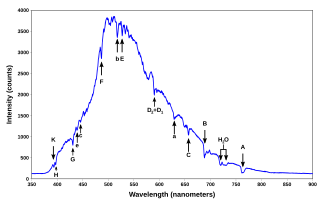
Partial impact theory is an astronomical theory describing the partial collision of two stars and the temporary creation of a bright third star as a consequence. The theory was explained in Alexander William Bickerton's book The Romance of the Heavens published in 1901.

Astronomy is a natural science that studies celestial objects and phenomena. It applies mathematics, physics, and chemistry in an effort to explain the origin of those objects and phenomena and their evolution. Objects of interest include planets, moons, stars, nebulae, galaxies, and comets; the phenomena also includes supernova explosions, gamma ray bursts, quasars, blazars, pulsars, and cosmic microwave background radiation. More generally, all phenomena that originate outside Earth's atmosphere are within the purview of astronomy. A branch of astronomy called cosmology is the study of the Universe as a whole.

A star is an astronomical object consisting of a luminous spheroid of plasma held together by its own gravity. The nearest star to Earth is the Sun. Many other stars are visible to the naked eye from Earth during the night, appearing as a multitude of fixed luminous points in the sky due to their immense distance from Earth. Historically, the most prominent stars were grouped into constellations and asterisms, the brightest of which gained proper names. Astronomers have assembled star catalogues that identify the known stars and provide standardized stellar designations. However, most of the estimated 300 sextillion (3×1023) stars in the Universe are invisible to the naked eye from Earth, including all stars outside our galaxy, the Milky Way.

Professor Alexander William Bickerton was the first professor of Chemistry at Canterbury College in Christchurch, New Zealand. He is best known for teaching and mentoring Ernest Rutherford. He was a natural teacher though an eccentric one, who taught science in an exciting way. His differences weren't limited to teaching as he formed a socialist community in Christchurch, which he later set up as a theme park. His partial impact theory explaining the appearance of temporary stars was the major work of his lifetime.
It is not part of contemporary astrophysics.
In The Romance of the Heavens Bickerton states that a slight "grazing" collision between stars would be much more common than a head on impact between stars. So he believed this phenomenon needed to be explained to account for the appearance of bright new stars that would appear in the night sky and disappear within a year or even days.
The theory explains that when the two stellar bodies graze each other, the grazed parts will shear off from the main body of each star. Their velocity will cancel each other's out transforming this energy into heat. While the main mass of each star will continue moving as they did before the collision. The third body created from the two sheared parts of the stars will form between the two original stars.
The temporary star expands after the impact displaying an intense increase in light, after all molecular reactions have taken place the light is replaced by a hollow shell of gas or possibly a planetary nebula, and eventually dissipates into space. Bickerton explains this bright temporary star by saying that it doesn't disappear due to cooling, but that it was too hot to hold together.

A planetary nebula, abbreviated as PN or plural PNe, is a type of emission nebula consisting of an expanding, glowing shell of ionized gas ejected from red giant stars late in their lives.

Space is the boundless three-dimensional extent in which objects and events have relative position and direction. Physical space is often conceived in three linear dimensions, although modern physicists usually consider it, with time, to be part of a boundless four-dimensional continuum known as spacetime. The concept of space is considered to be of fundamental importance to an understanding of the physical universe. However, disagreement continues between philosophers over whether it is itself an entity, a relationship between entities, or part of a conceptual framework.
The temperature of the third star, isn't dependent on the amount of contact between the two original stars, but rather the chemical makeup of the stars and their velocities going into the collision. The stability of the third body depends on the size of the contact of the original stars, if the contact was small then the mass of the newly created third body will find it harder to attract molecules to it. Rather than if it had a larger mass where molecules would find it more difficult to escape from its larger gravitational pull. [1]











